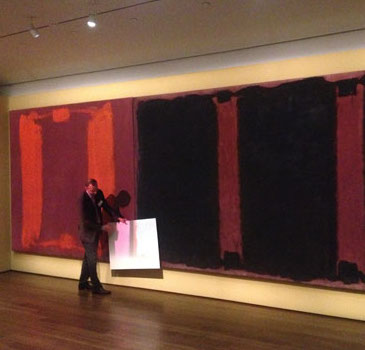Paint matters
There’s no substitute for the actual painting. The physicality of paint matters. This was nicely put earlier this month in a letter to the editor from The New Yorker, Feb. 1, 2016,
THE RESTORER’S ROLE
In discussing the digital component of the artist Josh Kline’s work, which relies on technology that doesn’t yet exist, Ben Lerner makes a comparison to the computer-generated restoration of the “Harvard Murals,” a suite of paintings by Mark Rothko. In the early nineteen-sixties, as an apprentice in the conservation department of Harvard’s Fogg Art Museum, I was among the crew that worked with Rothko on the installation. Lerner describes the murals’ recent exhibition at the Harvard Art Museum, in which color that was fading was made more vivid by the projection of computer-generated hues. Lerner suggests that the original art may not be necessary if projectors could produce the same effects. As the former head of conservation at the Harvard University Art Museums, I disagree. I maintain that the experiment with projected color brought us closer to that of the originals. Lerner did not see the exhibition, but, had he been there, he would have been able to experience the haptic effect of Rothko’s brushwork, seen on a huge scale. The colored light did not obscure the painter’s application of layers of various media—egg white, glue-size, oil—that suffuse the clouded, glowing expanse of canvas. Hue and substance were reintegrated. Though Lerner questions whether “the present’s notion of its past and future are changeable fictions,” he gives short shrift to the aim of conservationists, which is to find ever more accurate and responsible methods of preserving and restoring original works of art.
Marjorie B. Cohn Arlington, Mass.

Comments are currently closed.